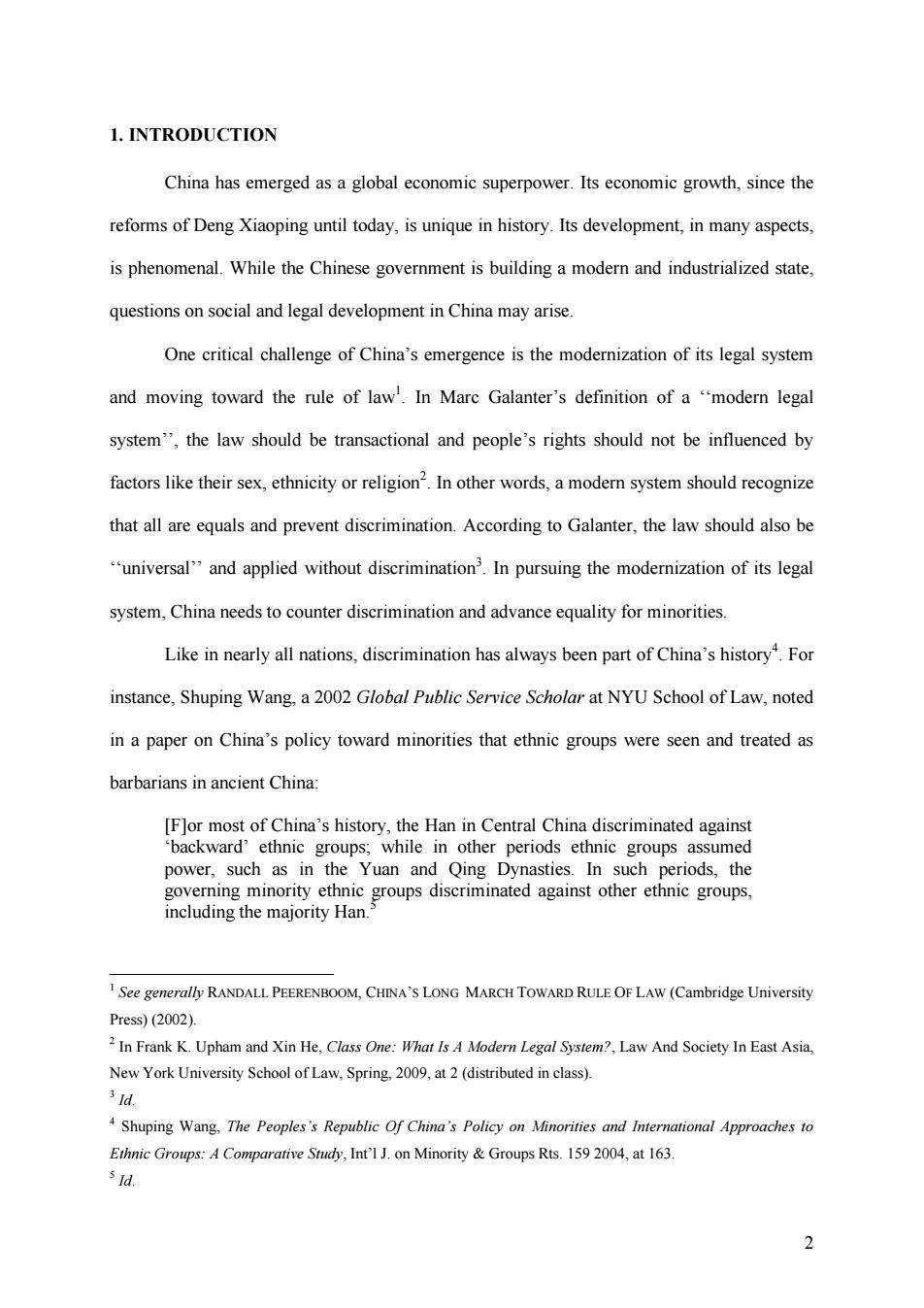正在加载图片...

1.INTRODUCTION China has emerged as a global economic superpower.Its economic growth,since the reforms of Deng Xiaoping until today,is unique in history.Its development,in many aspects, is phenomenal.While the Chinese government is building a modern and industrialized state, questions on social and legal development in China may arise. One critical challenge of China's emergence is the modernization of its legal system and moving toward the rule of law'.In Marc Galanter's definition of a "modern legal system',the law should be transactional and people's rights should not be influenced by factors like their sex,ethnicity or religion2.In other words,a modern system should recognize that all are equals and prevent discrimination.According to Galanter,the law should also be "universal"and applied without discrimination'.In pursuing the modernization of its legal system,China needs to counter discrimination and advance equality for minorities. Like in nearly all nations,discrimination has always been part of China's history For instance,Shuping Wang,a 2002 Global Public Service Scholar at NYU School of Law,noted in a paper on China's policy toward minorities that ethnic groups were seen and treated as barbarians in ancient China: [F]or most of China's history,the Han in Central China discriminated against backward'ethnic groups;while in other periods ethnic groups assumed power,such as in the Yuan and Qing Dynasties.In such periods,the governing minority ethnic groups discriminated against other ethnic groups, including the majority Han. 1 See generally RANDALL PEERENBOOM,CHINA'S LONG MARCH TOWARD RULE OF LAW (Cambridge University Press)(2002). 2 In Frank K.Upham and Xin He,Class One:What Is A Modern Legal System?,Law And Society In East Asia, New York University School of Law,Spring,2009,at 2(distributed in class). 31d. A Shuping Wang,The Peoples's Republic Of China's Policy on Minorities and International Approaches to Ethnic Groups:A Comparative Study,Int'l J.on Minority Groups Rts.159 2004,at 163 51d. 22 1. INTRODUCTION China has emerged as a global economic superpower. Its economic growth, since the reforms of Deng Xiaoping until today, is unique in history. Its development, in many aspects, is phenomenal. While the Chinese government is building a modern and industrialized state, questions on social and legal development in China may arise. One critical challenge of China’s emergence is the modernization of its legal system and moving toward the rule of law1 . In Marc Galanter’s definition of a ‘‘modern legal system’’, the law should be transactional and people’s rights should not be influenced by factors like their sex, ethnicity or religion2 . In other words, a modern system should recognize that all are equals and prevent discrimination. According to Galanter, the law should also be ‘‘universal’’ and applied without discrimination3 . In pursuing the modernization of its legal system, China needs to counter discrimination and advance equality for minorities. Like in nearly all nations, discrimination has always been part of China’s history4 . For instance, Shuping Wang, a 2002 Global Public Service Scholar at NYU School of Law, noted in a paper on China’s policy toward minorities that ethnic groups were seen and treated as barbarians in ancient China: [F]or most of China’s history, the Han in Central China discriminated against ‘backward’ ethnic groups; while in other periods ethnic groups assumed power, such as in the Yuan and Qing Dynasties. In such periods, the governing minority ethnic groups discriminated against other ethnic groups, including the majority Han.5 1 See generally RANDALL PEERENBOOM, CHINA’S LONG MARCH TOWARD RULE OF LAW (Cambridge University Press) (2002). 2 In Frank K. Upham and Xin He, Class One: What Is A Modern Legal System?, Law And Society In East Asia, New York University School of Law, Spring, 2009, at 2 (distributed in class). 3 Id. 4 Shuping Wang, The Peoples’s Republic Of China’s Policy on Minorities and International Approaches to Ethnic Groups: A Comparative Study, Int’l J. on Minority & Groups Rts. 159 2004, at 163. 5 Id